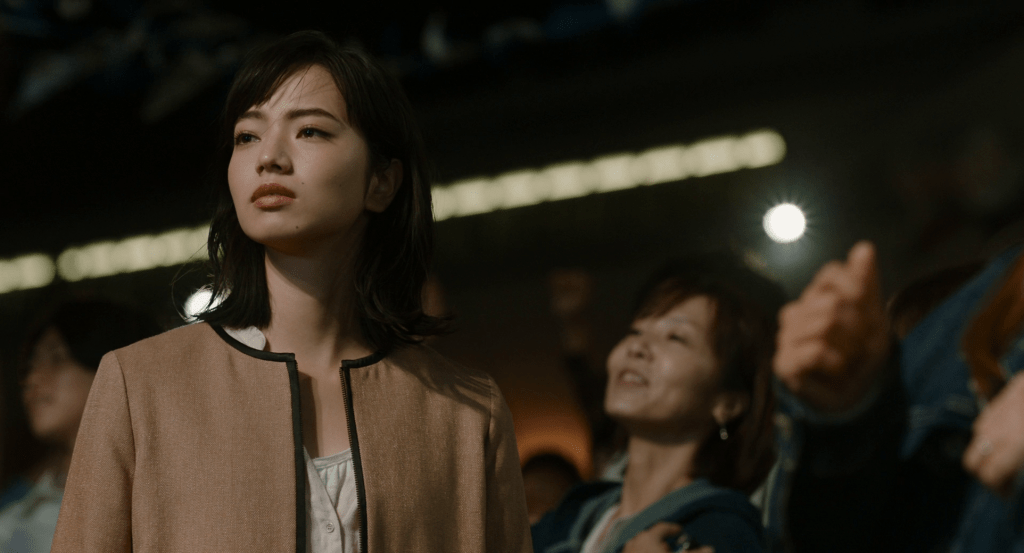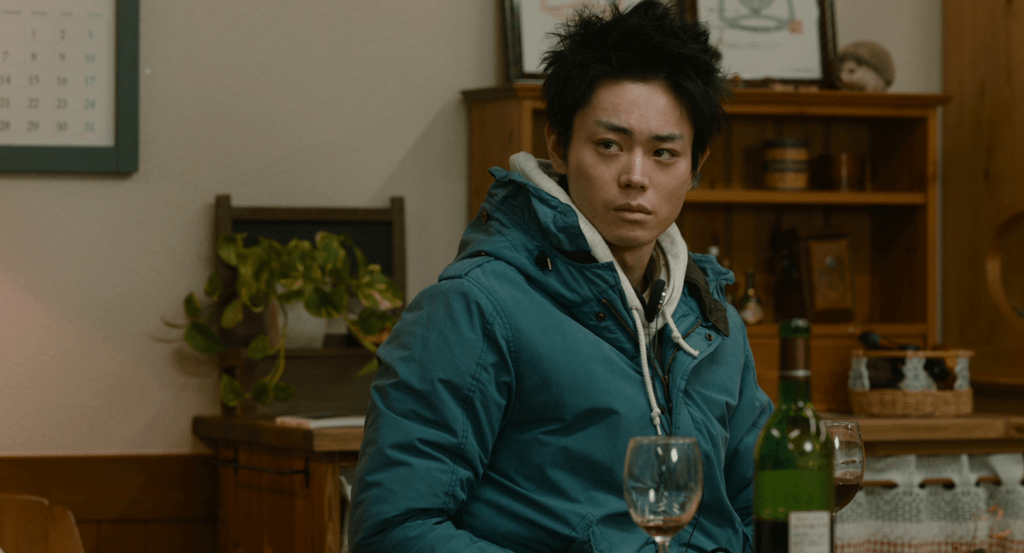Introduction
Takahisa Zeze is a director that has been gradually expanding his oeuvre. While his roots are in Pink film, establishing himself as one of the leading directors of the pink film genre, in recent years he has tried his hand at diverse genres. He made dramas like Heaven’s Story (2010), thrillers (Pandemic (2009)), action films (Strayer’s Chronicle (2015)), and even a period drama with The Chrysanthemum and the Guillotine (2018). One of Zeze’s latest films, Tapestry (2020), a film based on Miyuki Nakajima’s famous song Ito, is, in this respect, a romance narrative.
Review
One night, after watching the Biei summer fireworks, thirteen-year-old Aoi Sonoda (Nana Komatsu) has a chance encounter (or an encounter driven by the thread of fate) with Ren Takahisa (Masaki Suda). They fall in love with each other, but before their romance is truly able to blossom, she is suddenly taken away from him.
Seven years later, Ren travels from Hokkaido to Tokyo to attend the wedding of his friend Naoki Takehara (Ryo Narita). At the wedding, he meets Aoi again. Yet, he soon comes to realize that she is dating someone, Daisuke Mizushima (Takumi Saito). A year later, they meet again in Biei, but, as both are dating someone, the intimate moment they share is unable to blossom into something more. They part ways, without knowing if they will ever meet again.
Tapestry is a slice-of-life romance narrative, following, over the span of 18 years, the lives of Ren and Aoi. Their first encounter at the age of thirteen blossoms into a youthful romance, but their romance, while providing joy for both, is essentially a romance structured by a failed inter-subjective encounter.
The failure of their encounter becomes evident in the difference that exist between both subjects at the level of their youthful dreams. While Ren has many dreams (e.g. becoming part of the Japanese national team, become active internationally as soccer player), Aoi has no dreams, resigned herself to living an uneventful mundane life. This difference evokes that, despite their love for each other, their relationship is marked by a subtle divide, a divide originating from the fact that something cannot be said by Aoi and Ren’s inability to hear the echoes of what remains unsaid in her speech. In other words, while their youthful romantic encounter provides pleasure at the imaginary level – Aoi’s happiness, their encounter is essentially marked by a failure to bring her traumatic unsaid into play and meet each other as subject.
Even when Ren, some time later, has come to understand Aoi’s highly volatile family context – i.e. her imprisonment by a mother that neglects her and her mother’s lover who physically abuses her, he fails to meet her at the level of her subject. While running away with her seems like a grand romantic gesture, it is, at the same time, a gesture that erases her subjective desire. Ren imposes his desire on her, silencing her subjective speech once more. While the act of running away is a failed romantic gesture, Ren’s statement ‘I’ll protect you’ is not. His statement is a true subjective commitment, a symbol of his love that drives him towards Aoi. That Aoi does not fail to hear his subjective commitment is underlined by her subsequent act, i.e. the kiss.
The second encounter of Ren and Aoi is a mistimed one. Their short encounter at the wedding is marked by a certain awkwardness, a certain unbridgeable distance. This awkwardness is not function of Ren’s failure to realize his own subjective commitment, but originates from the lingering fantasy of that what could never be – i.e. their imagined ideal romance. Ren has, in fact, not given up on this fantasy. That is why seeing Aoi in Tokyo with Daisuke Mizushima renders him absent minded – the threatening impossibility of his fantasy haunting his mind (Narra-note 1). Yet, due to this missed-timed encounter Ren tries everything to quell the impossible romantic fantasy that lingers in his mind – e.g. he starts dating his senior, Kaori Kirino (Nana Eikura), at the cheese company.
The third encounter is, just like the second, mistimed. While this encounter is not marked by any awkwardness, one easily senses that some distance persists between Aoi and Ren. They speak which each other but, due to the wrong timing of their encounter, they cannot vocalize directly what lingers in their unconscious, they cannot realize what they desire unconsciously. While they momentarily meet each other inter-subjectively, they feel forced, due to their current circumstances, to let go of each other’s hands once more. The concatenation of failed or mistimed encounters make it rather easy to formulate the main structuring question of Tapestry: Can Ren and Aoi find the right subjective time to meet the other, as subject, romantically from their own subjective position?
Some remarks about Aoi are necessary. She is a woman who wants to guard her (financial) independence so that she does not fall into the violent claws of dependence, so that she can avoid being imprisoned in a relational dynamic that forces her to be exploited to ensure her survival. She is asomeone who does not want to be protected – to be in such position is to accept a certain dependency, but she strives to become someone who protects. We can thus describe Aoi as a woman who desperately wants to avoid being placed in the traditional female position of being a worshiped and protected idol and desires to be an active female force in society (Narra-note 2).
The composition of Tapestry is straightforward – a pleasant and well-balanced mix of fluid dynamic and static shots. Yet, notwithstanding the straightforward nature of the composition, Zeze does not leave any chance unused to please the spectator with some beautifully shots of Hokkaido’s nature and Tokyo’s skyline.
One element that stands out in the composition is Zeze’s thoughtful use of slow-motion. The reason why his use of slow-motion is so effective is because the slow-motion succeeds in strengthening the emotional import of an event or an act for Aoi and/or Ren. It is, furthermore, by underlining and strengthening these small events via slow-motion that the emotional dimension of their subjective struggle is punctuated for the spectator, which makes it easier for the spectator to invest emotionally in the narrative.
The narrative of Tapestry, for that matter, stands out due to its slice-of-life realism, the myriad of genuine touching moments, and the extremely moving finale (General-note 1, Narra-note 3 (spoiler)). Instead of abusing certain plot devices to artificially heighten the emotional impact of the narrative – something many Japanese romance narrative are guilty of, Tapestry’s emotional impact mainly depends on the natural and nuanced performances. The narrative’s touching moments are thus not emotional due to the abuse of any kind of cinematographical decorations, but because the cast – Masaki Suda, Nana Eikura, Nana Komatsu in particular – infuses a genuine emotionality into the (often repeated) signifiers and acts that drive such scenes. The accumulation of these emotional signifiers and acts allows Zeze to deliver a truly emotionally satisfying finale. In this respect, Zeze made a wise choice to frame this slice-of-life romance narrative in a straightforward way – refraining from too much cinematographical decorations that may problematize the genuine feel of the emotions on display (Music-note 1).
Tapestry is an amazing romance narrative. Director Zeze and screenwriter Tamio Hayashi show that they fully understand that the true emotional power of a romance narrative depends on the performances and not on any compositional decorations or cheap narrative tricks to artificially (and undeservedly) provoke the emotions of the spectator. Yes, Zeze delivers a rather straightforward romance narrative with Tapestry, but, in contrast to many other Japanese romance films, he succeeds to genuinely move the spectator.
Notes
Narra-note 1: The fact that Ren has not given this fantasy up also puts his outburst at Kaori Kirino in a completely different light. Behind his violent attempt to force Kaori to give up on her failed youthful love, lies a subjective attempt to silence his own love for Aoi. The tear that rolls over his face is the signifier that underlines the double nature of his outburst.
Narra-note 2: The importance of her desire for independence is, in fact, the second aspect that Ren fails to acknowledge as thirteen-year-old. His youthful acts and his subjective commitment to protect her are, first and foremost, driven by his own selfish desire – what he wants takes precedence over what she wants.
Narra-note 3: Like many romance narratives, Tapestry also allows the spectator to imagine that the sexual relation can be written. The ability to move the spectator is, in our view, also based on the subtle but effective way Zeze fuels the fantasmatical possibility to realize such unwritable sexual relation.
General-note 1: We do think that the film drags a bit in the middle. Yet, this ‘drag’ is not enough to derail the narrative or problematize the emotional investment of the spectator.
Music-note 1: The smartness is also evident in how Zeze approached the music in Tapestry. Zeze carefully avoids using musical pieces to (undeservedly) heighten the emotion of given scenes. The careful utilization of music allows the finale, which does richly employ the song ‘Ito’ by Miyuki Nakajima, to become so moving, because the emotion of the finale is not function of the song as such, but of the accumulation of the emotional narrative moments that give the signifiers of the song its power to emotionally impact the spectator.






One Comment Add yours